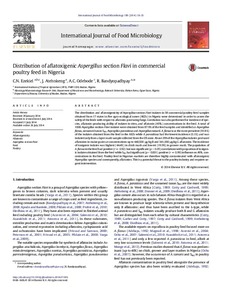| dc.contributor.author | Ezekiel, C.N. |
| dc.contributor.author | Atehnkeng, J. |
| dc.contributor.author | Odebode, A.C. |
| dc.contributor.author | Bandyopadhyay, Ranajit |
| dc.date.accessioned | 2019-12-04T11:03:24Z |
| dc.date.available | 2019-12-04T11:03:24Z |
| dc.date.issued | 2014-10 |
| dc.identifier.citation | Ezekiel, C.N., Atehnkeng, J., Odebode, A.C. & Bandyopadhyay, R. (2014). Distribution of aflatoxigenic Aspergillus section Flavi in commercial poultry feed in Nigeria. International Journal of Food Microbiology, 189, 18-25. |
| dc.identifier.issn | 0168-1605 |
| dc.identifier.uri | https://hdl.handle.net/20.500.12478/1041 |
| dc.description.abstract | The distribution and aflatoxigenicity of Aspergillus section Flavi isolates in 58 commercial poultry feed samplesobtained from 17 states in five agro-ecological zones (AEZs) in Nigeria were determined in order to assess thesafety of the feedswith respect to aflatoxin-producing fungi. Correlation was also performed for incidence of species,aflatoxin-producing ability of isolates in vitro, and aflatoxin (AFB1) concentrations in the feed. A total of1006 Aspergillus section Flavi isolates were obtained from 87.9% of the feed samples and identified as Aspergillusflavus, unnamed taxon SBG, Aspergillus parasiticus and Aspergillus tamarii. A. flavuswas themost prevalent (91.8%)of the isolates obtained from the feed in the AEZs while A. parasiticus had the lowest incidence (0.1%) and wasisolated only froma layer mash sample collected fromthe DS zone. About 29% of the Aspergillus isolates producedaflatoxins in maize grains at concentrations up to 440,500 ?g/kg B and 341,000 ?g/kg G aflatoxins. The incidenceof toxigenic isolates was highest (44.4%) in chick mash and lowest (19.9%) in grower mash. The population ofA. flavus in the feed had positive (r= 0.50) but non significant (p N 0.05) correlations with proportion of toxigenicisolates obtained fromthe feedwhile SBG had significant (p b 0.001) positive (r= 0.99)influence on AFB1 concentrationsin the feed. Poultry feed in Nigerian markets are therefore highly contaminated with aflatoxigenicAspergillus species and consequently, aflatoxins. This is a potential threat to the poultry industry and requires urgentintervention. |
| dc.format.extent | 18-25 |
| dc.language.iso | en |
| dc.subject | Aflatoxins |
| dc.subject | Aspergillus |
| dc.subject | Feed Cereals |
| dc.subject | Poultry |
| dc.title | Distribution of aflatoxigenic Aspergillus section Flavi in commercial poultry feed in Nigeria |
| dc.type | Journal Article |
| dc.description.version | Peer Review |
| cg.contributor.affiliation | International Institute of Tropical Agriculture |
| cg.contributor.affiliation | Babcock University |
| cg.contributor.affiliation | University of Ibadan |
| cg.coverage.region | Africa |
| cg.coverage.region | West Africa |
| cg.coverage.country | Nigeria |
| cg.isijournal | ISI Journal |
| cg.authorship.types | CGIAR and developing country institute |
| cg.iitasubject | Aflatoxin |
| cg.journal | International Journal of Food Microbiology |
| cg.howpublished | Formally Published |
| cg.accessibilitystatus | Limited Access |
| local.dspaceid | 77970 |
| cg.identifier.doi | https://dx.doi.org/10.1016/j.ijfoodmicro.2014.07.026 |

